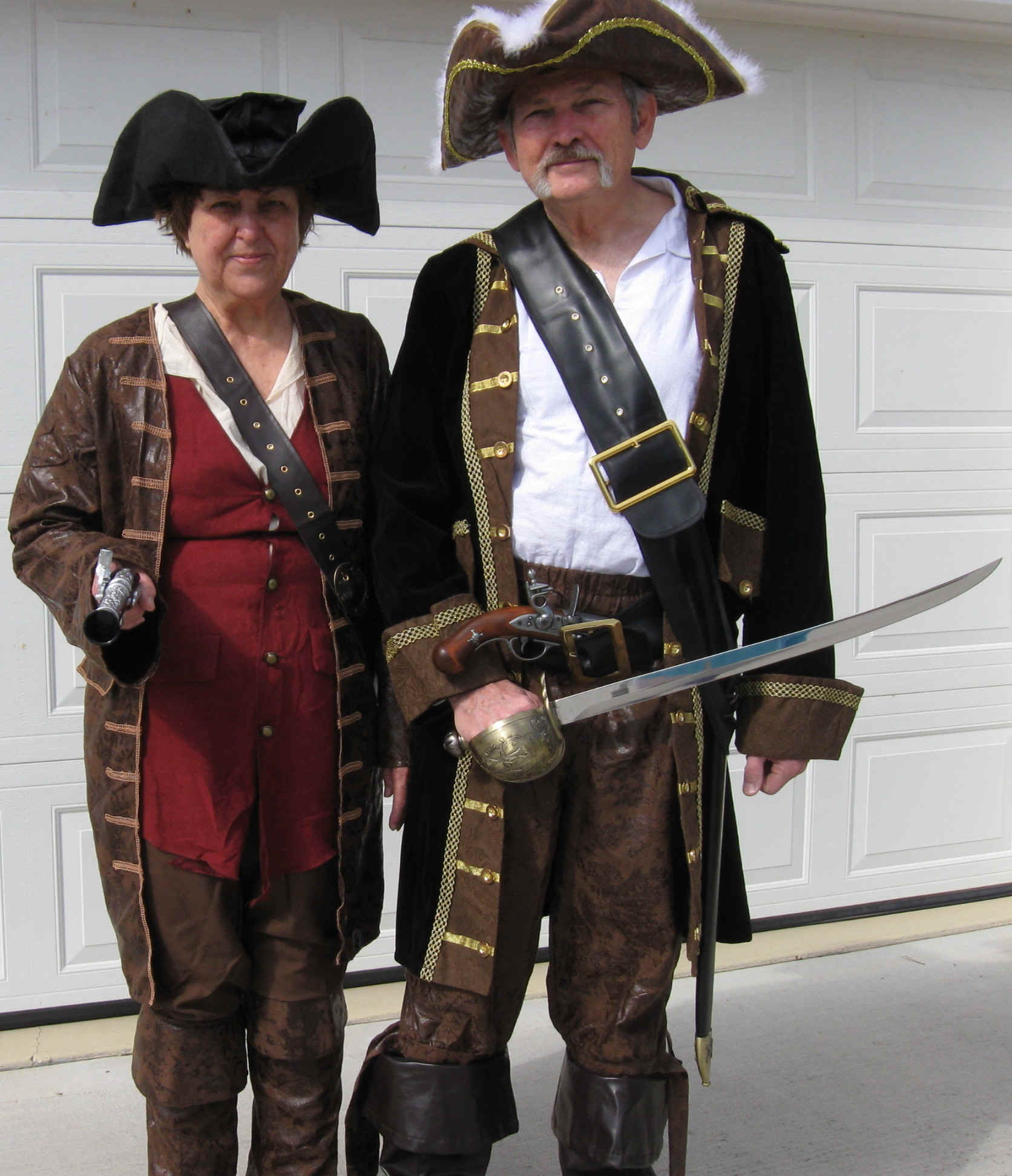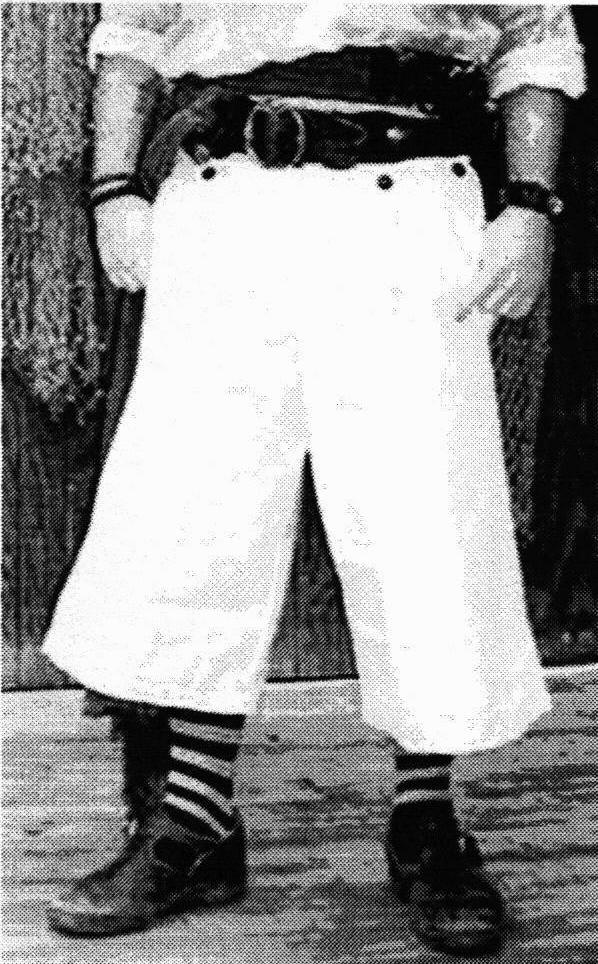East Tennessee Pirate Group Home
Pirate Clothing
Then:
Pirate crew wore whatever clothing they could find or capture. The pirates who operated during the Age of Exploration have become synonymous with a definite style of Pirate Clothing. But what pirate clothing was fact and what pirate clothing was fiction? The legendary apparel of a pirate has created a pirate stereotype. But much of the pirate clothing was developed through necessity and befitted the lifestyle of a pirate seaman.
The following list details the items of pirate clothing and some interesting facts and information about various items of it.
Bright, miss-matched colors were refereed to as motley clothing.
A bandana was worn to kept the sweat out of the pirate's eyes.
Pirate captains sometimes wore the tri-cornered hat made of various materials including leather.
The doublet or coat was an expensive item of pirate clothing. Long clothes, including the doublet were a style of pirate clothing best suited to land and were sometimes decorated with ornate braids and fabrics.
Breeches or trousers were generally only worn by English pirates.
Pirates often wore knitted caps called Monmouth caps.
A waistcoat was a flamboyant addition to pirate clothing.
Tight fitting drawers were worn to allow for the difficult tasks of a pirate.
Woolen stockings were worn as practical apparel and silk for land use.
;The puffed sleeved shirts were mostly suited to pirate clothing on land.
Pirate Accessories:
Gold Hoop Earrings were a sign of wealth but also believed to serve a practical purpose in easing sea sickness by applying pressure to ear lobes!
Bracelets, chains, pins and pendants of gold, silver, precious jewels and pearls also expressed wealth.
A sash or baldric made of fine fabrics, was sometimes overlaid with a leather sash to take the weight of pirate weapons.
Braids and ribbons adorned various elements of pirate clothing but were also used to braid a pirate beard or hair. Blackbeard was famous for tying black braids to his beard and hair and famous for sticking lighted matches under his hat on either side of his face to terrify his enemies.
Pirate Boots ranged from boot covers, to Bucket boots up to thigh-high boots, Pirate seamen often went barefoot - a practical decision when a task might include 'swabbing the deck.
Wide belts were worn around the waist and diagonally across the shoulder in order to take the weight of pirate weapons.
Ornate buckles were used to adorn pirate belts and shoes.
Fancy buttons were a decorative addition to pirate clothing.
Scarves were also a flamboyant addition to pirate clothing.
Wigs stolen or purpose made were often favored by Pirate captains.
Many pirates were recruited from unemployed seaman - there was plenty of work for a fighting sailor during times of wars but during peacetime the seaman became impoverished and turned to a life of piracy. In 1628 the British Admiralty established sailor's clothing (which were called 'slops') to be worn by men who had been press-ganged. This type of clothing consisted of a canvas doublet and breeches, knitted caps called Monmouth caps, cotton waistcoats and drawers, stockings, linen shirts and shoes. Much of this clothing was adopted by the seamen who turned to the life of a pirate.
The woolen cap referred to as the Monmouth Cap dates back to the 1500's. In 1571 the Elizabethan Sumptuary Laws were passed which ordered everyone over the age of six to wear a woolen cap on Sundays and holidays in order to help England's wool trade! The Upper Classes were excused from obeying this law!
Elizabethan Sumptuary Laws dictated what color of clothing and the materials and fabrics that could be used for each social level. The Elizabethan Sumptuary Laws therefore enforced what clothing individuals were allowed to own and wear, an easy and immediate way to identify rank and privilege. Pirate clothing, especially that of the successful and wealthy pirates took great delight in flouting the Elizabethan Sumptuary Laws! Anything went - fine velvets and silks and such fabrics which had been previously banned to anyone other than those in the Upper Classes.
The fabrics used in pirate clothing depended on how wealthy they were and what clothing had been stolen! Pirate clothing for the ordinary seamen was therefore often ill-fitting! Motley was a multi-colored woolen fabric woven of mixed threads in 14th to 17th century England. The clothes of pirate seamen were mismatched with multi-colors - hence the expression 'Motley Crew'.
Many of the tasks performed by the pirates were extremely arduous - clothing could be easily ripped, tattered and torn. The pirate clothing for ordinary seamen, by necessity was tight fitting. Loose fighting clothes would be dangerous when performing tasks like climbing the rigging. The clothing of the captain or pirate clothing worn on land did not need to follow such requirements.
The fabrics used in pirate clothing depended on how wealthy they were and what clothing had been stolen! But basically there were no rules! The practical fabrics used for ordinary pirate clothing included canvass, leather, wool, linen, cotton and sheepskin. The fabrics and materials used in pirate clothing when on shore, or by the Pirate Captain, were far more flamboyant and expensive. Velvet, silk, damask and taffeta were included in the fabrics and materials used for this type of pirate clothing - exotic feathers were also favored!
The colors of pirate clothing included the colors that had previously banned by the Elizabethan Sumptuary Laws. Crimson, violet, purple and deep blue were typical of the these colors!
Now:
 Your
clothing can be as elaborate or as simple as you like. Our clothing has
STARTED off as purchased items. We needed to get up and going as quickly as
possible. We have already begun to modify it. My purchased belt was not
strong enough to hold my pistol and had to be modified. Her outfit was
purchased and includes a plastic sword and pistol since she is Quarhrtmaster
(the one with the real authority aboard ship and our company president) and
she interacts directly with our passengers. My outfit was also purchased and
includes a real sword and a replica flintlock pistol. Both outfits have "boot toppers"
which we sewed to the bottom of the pants legs so they would stay up.
Your
clothing can be as elaborate or as simple as you like. Our clothing has
STARTED off as purchased items. We needed to get up and going as quickly as
possible. We have already begun to modify it. My purchased belt was not
strong enough to hold my pistol and had to be modified. Her outfit was
purchased and includes a plastic sword and pistol since she is Quarhrtmaster
(the one with the real authority aboard ship and our company president) and
she interacts directly with our passengers. My outfit was also purchased and
includes a real sword and a replica flintlock pistol. Both outfits have "boot toppers"
which we sewed to the bottom of the pants legs so they would stay up.
There are always more Captains and Quartermasters and it is MUCH easier to make a crew outfit. You can purchase crew outfits or you can make your own using the historical information above. Start out simple and improve your "kit" as your time, budget, and training permit. When you attend pirate fests TAKE PICTURES! Ask people how their outfit works and where they got it or how they made it. Most pirates are happy to share information if not booty or mates.
- Pants - any shorter than full length but longer that shorts and preferably longer than bermuda shorts.
- Shirts - unprinted golf shirts (no pocket) or plain tee shirt.
- Bandana - made from the front or back of an old, discarded tee shirt cut aproximately square and folded into a triangle.
- Sash - any colorful sash tied around the waist and falls on one side.
- Shoes - any leather; no tennis shoes, boating shoes, or loafers.
- Eye patch or hook - were typical of injured pirates (lost an eye or hand in battle) only if you like to look injured.
- Plastic, replica weapons - if you like or have them but NO metal weapons allowed.
- Gold, loop ear ring for the left ear - were sometines worn but certainly not necessary.
Beginning ptrate crew outfit includes:
